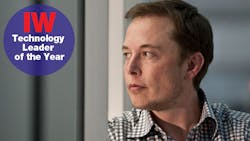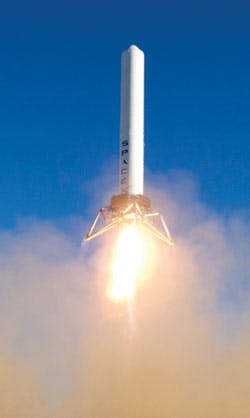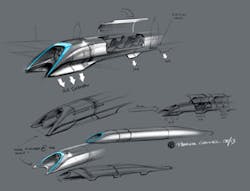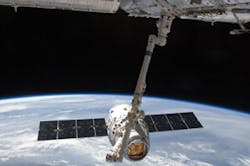Somewhere in the cloudless skies over the SpaceX proving grounds near McGregor, Texas, a gigantic 10-story rocket emerges from the smoke of liftoff and descends slowly, carefully to the landing pad. It comes to a rest just as spaceships should: balanced vertically, Buck Rogers-style, on four steaming hydraulic legs.
At mission control, SpaceX CEO and Chief Designer Elon Musk watches the show with an unimaginable satisfaction. The vertical takeoff / vertical landing Falcon 9 rocket (aka "Grasshopper") being tested out there represents the next big leap in the space industry — a cheap, reusable rocket that can not only withstand the stress of re-entry and multiple missions, but do so with comic-book style.
See Also: Manufacturing Industry Technology News & Trends
And that is the signature of a true Elon Musk project — one part hard science, one part cold business and one part straight up sci-fi.
It's that combination that has earned the 42-year-old South Africa native his place behind the controls at SpaceX — a company he founded in 2002 to serve (and define) the commercial space industry.
It's also that combination that has enabled his other company — Tesla Motors — to bring his utterly futuristic, utterly powerful electric cars from the narrow luxury market to mainstream America.
And, finally, it's that combination that has earned him his rank as IndustryWeek's 2013 Technology Leader of the Year.
A Clear Vision
Twenty years ago, IW began celebrating the scientists, leaders and visionaries who are responsible for shaping and advancing the progress of technology — be it high-tech gadgetry or lab science, software or hardware.
In the past, we have highlighted the work of Microsoft's (IW 500/16) Bill Gates and GE's (IW 500/6) Jeff Immelt, and even Francis Collins and J. Craig Venter, the pioneers of genomics. And now, Elon Musk, with his spaceships and Roadsters, his Hyperloop and software empires, joins their ranks. And deservedly so.
Musk, perhaps more than anyone in the industry today, maintains a clear vision for what real 21st century technology is supposed to do and what kind of future it is supposed to be creating.
In pursuit of that vision, through his early work at Paypal and Zip2, then SpaceX, Tesla and SolarCity, and with projects like the Hyperloop, 3-D modeling and autonomous driving, Musk has recreated, rejuvenated and redefined every industry he has encountered, from media and finance to transportation and energy.
Somewhere in there he has created a new world of technology according to his own idea of the future — a future based equally on physics and 50 years' worth of unfulfilled promises left by science fiction.
And in that vision is the logic of the future — the future according to Musk.
Creating a Perfect World
There's no reason for Elon Musk to be fiddling around with trains. With a new mass-market electric car on the brink of release from one of his companies and nearly 50 space missions already booked for the other, he should have more than enough to keep him busy. But when California began its billion-dollar high-speed rail project earlier this year, he just couldn't help himself.
"How could it be that the home of Silicon Valley and JPL — doing incredible things like indexing all of the world's knowledge and putting rovers on Mars — would build a bullet train that is both one of the most expensive per mile and one of the slowest in the world?" he wrote on Tesla's website in August.
See Also: 2013 Technologies of the Year [SLIDESHOW]
The train, he explained, would be both slower and more expensive to operate than flying, not to mention more dangerous by two orders of magnitude. The whole project, despite its potential — or maybe because of it — was just a disappointment, he said.
So Musk did what anyone would do in his position: He invented a whole new mode of transportation.
The Hyperloop, as he calls it, was drawn up in an epic all-night design session, and could one day connect distant cities via a high subsonic speed pneumatic-driven train that could take travelers from, say, San Francisco to L.A. in about 30 minutes.
The details for the project are still sketchy and still very much in progress, but that's not the point. The point is the process.
Musk's work on the Hyperloop illuminates the creative logic at work that has allowed him to contribute so heavily to American industry in his brief, 18-year career. It contains all the secrets to what has made him a technology leader unlike any other.
In a perfect world, a world in which technology constantly advances, where there are people on board, eager to invest in those advances to keep the improvement going, Musk would be just another Silicon Valley engineer tinkering in a lab.
But the world isn't perfect. The U.S. has abandoned space exploration, alternative energies and sustainable transportation. Technology is not improving at the rate Musk and his generation grew up expecting. In short, the future Musk envisioned for himself and the world wasn't happening on its own. So he's had no choice but to create a better world himself.
The Grandest Adventure
"If you asked people in 1969 what 2013 would look like, they would have said there'd be a base on the moon… and maybe there'd even be a base on Mars or space hotels and awesome stuff in space," Musk told students at the Khan Academy in April 2013.
"That's what people expected," he said. But with budget cuts and waning public interest in space exploration (or at least in paying for exploration), the United States in 2013 can't even send an astronaut into orbit.
And that, he said, is unacceptable.
At the same time, another piece of Musk's vision — the one that first brought him to Silicon Valley fresh out of the University of Pennsylvania in 1995 — has faced the same disappointing neglect.
Back then, the electric car industry seemed ready to explode — General Motors (IW 500/5) had its EV-1s on the market, Toyota (IW 1000/8) had its RAV-4 and the whole auto industry was buzzing with excitement. It was enough to convince Musk — and much of the world — that the market was ready for electric.
"But when California relaxed its regulations on electric cars [in 2000]," Musk recalled, "GM suddenly recalled all of its EV-1s and crushed them into tiny cubes." And that, he said, was the end of the buzz.
Which was also unacceptable.
Facing those disappointments, Musk dedicated his teams at SpaceX and Tesla to rebuild both the space and electric vehicle markets from scratch, something he took only a little over a decade to accomplish.
He did so by digging deep into his reserves — investing about half of his piece of the $1.5 billion PayPal buyout in SpaceX alone — and pursuing a different business tactic.
"You can run a company where you're really under the gun to make a lot of short-term optimizations," he explained. "But that makes it difficult to make big technology advancements."
Rather than betting on that model, Musk decided to play to the future — to forward the cause of space and electric vehicles even when it wasn't exactly the most commercially viable or profit-maximizing option.
At SpaceX, that meant spending time and cash to develop a cheaper rocket, with new designs and fancy money-saving tricks like the Grasshopper's Buck Rogers maneuvers.
The company also needed a customer — something it lacked for nearly 10 years of development.
And then it struck gold this year.
"We developed the Dragon spacecraft rather optimistically because NASA announced that they were going to retire their space shuttles and were going to put out a bid to commercial industry for the first time in NASA history," Musk explained. "We were lucky enough to win one of those contracts."
As such, SpaceX became the first U.S. private company to deliver supplies to the International Space Station — an event that marked a near flawless success from the company and a rebirth of the American space program in general.
Obviously Better
On the Tesla side, Musk knew he had to do something a little different to break into the market.
"If you're a newcomer product, it's not really enough just to be as good as the incumbent product," he explained. "In order to get people to change, you have to do something that's meaningfully better."
The goal, he said, was to change people's thinking in respect to electric cars. With current technology, they didn't have to be low-performance, low-range golf carts anymore.
"I wanted to have something that was really profitable, better than a gasoline car for driving long distances, not just equal to gasoline cars," he said.
"I wanted to make something obviously better."
To do so, Musk needed something big, something groundbreaking and expectation shattering. And he needed it in a hurry at a time when he was still refining the technology and still working out the manufacturing details.
What he came up with was the super fast, super powerful Tesla Roadster, a two-seat all-electric sports car that hit the market for about $100,000 — a screaming image of the future if ever there was one. And one that paved the way for a whole new industry.
The Roadster — a high-end luxury car at high-end luxury cost — provided Musk with enough capital and enough press to allow him to ramp up production of the next model that hit the showroom this year: the Model S — a feature-rich, accessible version of the car, which was dubbed "the safest car in America" by the National Highway Traffic Safety Administration this year.
On the strength of that, and the excitement already building around the next iteration — the Model X SUV due out in 2014 — Musk managed to pull a profit out of the company this year for the first time in its 10-year history.
Validation
And this, one could say, is the real test of Musk's vision and his ability to shape it. After 10 years of losses, 10 years of profitless labor and experimentation, Musk has begun to create a world where investors can buy spaceships online, where private citizens can break out of orbit or create new businesses in outer space. It's a world in which families can drive across the country in electric cars charged through a network of solar powered stations or executives can dip across hundreds of miles in minutes without leaving the ground.
It's a future that suddenly looks a lot like the one we have been promised.
About the Author
Travis M. Hessman
Editor-in-Chief
Travis Hessman is the editor-in-chief and senior content director for IndustryWeek and New Equipment Digest. He began his career as an intern at IndustryWeek in 2001 and later served as IW's technology and innovation editor. Today, he combines his experience as an educator, a writer, and a journalist to help address some of the most significant challenges in the manufacturing industry, with a particular focus on leadership, training, and the technologies of smart manufacturing.



